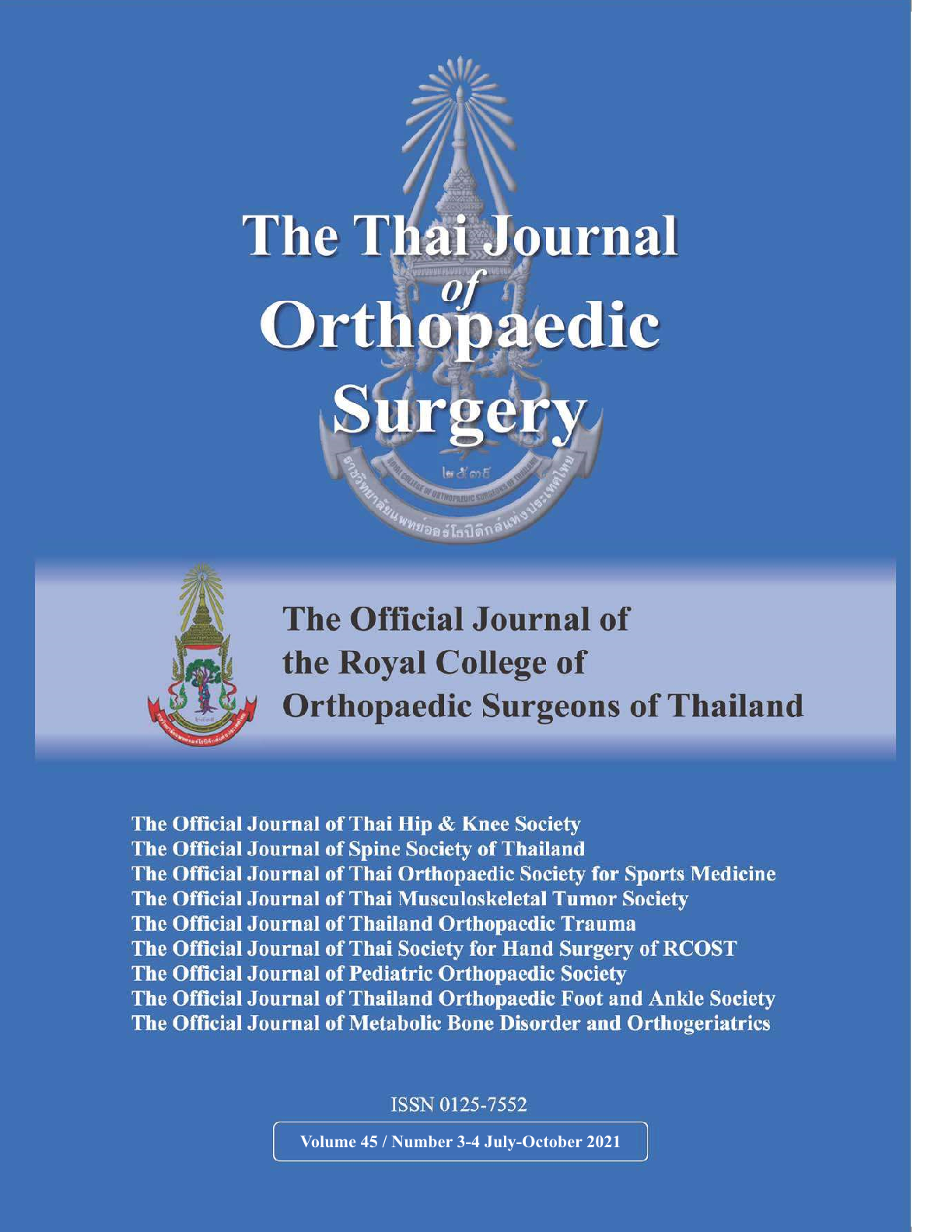The Prevalence and Correlation of Foot Deformity in Primary Osteoarthritis of the Knee
Main Article Content
Abstract
Background: Foot deformities have long been recognized as highly prevalent in older people. Knee osteoarthritis (OA) is a common painful and chronic condition that affects a large proportion of older people. The presence of foot deformities increase disability levels in knee osteoarthritis.
The purpose of our study is to investigate the prevalence and correlation of foot deformity in primary knee OA.
Methods: The study design was a cross-sectional survey study of the primary OA knee patients during 4 years period presented in the IPD and OPD patient in Siriraj Orthopedic Department. 113 patients were enrolled in the study. The measure for the association was between the femur-tibia angle (FTA), the hallux valgus angle (HVA), the intermetatarsal angle (IMA), and the calcaneal pitch angle.
Results: The prevalence of foot deformities in primary OA knee patients was 70.5% (n=80). The prevalence of the hallux valgus, pes planus and hind foot varus in primary OA knee patients were 51.9%, 41.8%, and 32.9%. The radiographic measurements have no statistically significant association between the alignment of osteoarthritis of the knee (the femur-tibia angle) and foot deformities. No significant association was seen between the femur-tibia angle (FTA), the hallux valgus angle (HVA), the intermetatarsal angle (IMA), and the calcaneal pitch.
Conclusions: The prevalence of foot deformities is significantly higher in OA knee. Hallux valgus, pes planus and hind foot varus were the most common foot deformity associated with OA knee.
Article Details
References
2. Paterson KL, Hinman RS, Hunter DJ, Wrigley TV, Bennell KL. Impact of concurrent foot pain on health and functional status in people with knee osteoarthritis: data from the osteoarthritis initiative. Arthritis Care Res (Hoboken). 2015; 67(7): 989-95.
3. Thomas MJ, Roddy E, Zhang W, Menz HB, Hannan MT, Peat GM. The population prevalence of foot and ankle pain in middle and old age: a systematic review. Pain. 2011; 152(12): 2870-80.
4. Guler H, Karazincir S, Turhanoglu AD, Sahin G, Balci A, Ozer C. Effect of coexisting foot deformity on disability in women with knee osteoarthritis. J Am Podiatr Med Assoc. 2009; 99(1): 23-7.
5. Levinger P, Menz HB, Fotoohabadi MR, Feller JA, Bartlett JR, Bergman NR. Foot posture in people with medial compartment knee osteoarthritis. J Foot Ankle Res. 2010; 3: 29.
6. Chandler JT, Moskal JT. Evaluation of knee and hind foot alignment before and after total knee arthroplasty. J Arthroplasty. 2004; 19(2): 211-6.
7. Chuckpaiwong B, Nunley JA, 2nd, Queen RM. Correlation between static foot type measurements and clinical assessments. Foot Ankle Int. 2009; 30(3): 205-12.
8. Canale ST, Beaty JH. Campbell's Operative Orthopaedics, 11th ed. 11 ed. Philadelphia, PA: Mosby/Elsevier; 2007. p. 4587.
9. Lin YC, Mhuircheartaigh JN, Lamb J, Kung JW, Yablon CM, Wu JS. Imaging of adult flat foot: Correlation of radiographic measurements with MRI. AJR Am J Roentgenol. 2015; 204(2): 354-9.
10. Canale ST, Beaty JH. Campbell's Operative Orthopaedics, 11th ed. 11 ed. Philadelphia, PA: Mosby/Elsevier; 2007. p. 4471.
11. Magee DJ. Orthopedic physical assessment, 5th Edition. Fourth edition. Philadelphia : Saunders, [2008]; 2008. p. 855.
12. Iijima H, Ohi H, Isho T, Aoyama T, Fukutani N, Kaneda E, et al. Association of bilateral flat feet with knee pain and disability in patients with knee osteoarthritis: A cross-sectional study. J Orthop Res. 2017; 35(11): 2490-8.
13. Golightly YM, Hannan MT, Dufour AB, Hillstrom HJ, Jordan JM. Foot disorders associated with overpronated and oversupinated foot function: the Johnston County osteoarthritis project. Foot Ankle Int. 2014; 35(11): 1159-65.
14. Hogan MT, Staheli LT. Arch height and lower limb pain: an adult civilian study. Foot Ankle Int. 2002; 23(1): 43-7.


